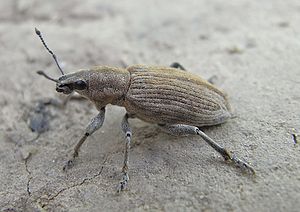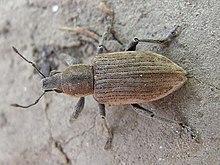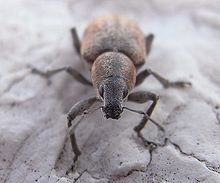True extinct weevil
| True extinct weevil | ||||||||||||
|---|---|---|---|---|---|---|---|---|---|---|---|---|

Real extinct weevil on dirt road |
||||||||||||
| Systematics | ||||||||||||
|
||||||||||||
| Scientific name | ||||||||||||
| Tanymecus palliatus | ||||||||||||
| ( Fabricius , 1787) |
The common weevil ( Tanymecus palliatus ), also known as the sugar beet weevil , is a beetle from the family of weevils and the subfamily Entiminae. The beetle is widespread in Central Europe.
Name and synonyms
The scientific genus name Tanymecus is from Altgr. τανύ tany , "elongated" and μήκος mēkos "length" derived. So it means "the elongated one", refers to the physique and also explains the German generic name "Streckrüssler". The specific epithet "palliatus" means Latin "provided with a coat". The reference to the beetle is unclear.
Because of its variability, the beetle has been described several times as a new species, and there are ten species names synonymous with paliatus Fabricius 1787 (angustulus Fairmaire 1879, canescens Herbst 1795, diffinis Marsham 1802, glis Rossi 1794, graminicola Olivier 1807, necessarius Mocquerys 1874, revelieri Tournier 1874 , sareptanus Desbrochers 1871, setulosus Chevrolat 1879) Some of these synonyms explain further properties that the beetle is somewhat narrow (lat.angustulus somewhat narrow), lives on the ground (lat.graminicola grass dwellers) can be gray-white in color (lat.canescens gray-white) and (the pronotum at the front side) is occupied with brooches (lat. setulosus with brooches). The name sugar beet weevil comes from the fact that it is occasionally harmful to sugar beet.
Characteristics of the beetle
The elongated body reaches a length of eight to twelve millimeters. The upper side has short hairs and between this basic hair is uniformly light or irregularly blotchy.
The head is stretched forward. The mouthparts sit on an extension of the head, the trunk. The trunk is hardly longer than it is wide. It is thickened on the underside and set off from the head by a transverse furrow. The pit in which the kneeling feelers are pivoted lies on the side of the head and can only be partially seen from above. It runs straight towards the eyes and goes out in front of them. The shaft of the antennae is about as long as the flagellum; when placed backwards, it protrudes beyond the rear edge of the eyes. The scourge consists of seven slightly stretched limbs and ends in a multi-limbed club. The round eyes are wider than high and slightly curved.
The pronotum is significantly longer than it is wide. The sides of the pronotum are only slightly expanded outward, with no edge or bulge. The front edge of the pronotum is covered with long hair fringes on the lower side. The base of the pronotum is straight.
The elytra are significantly wider than the pronotum, its sides are almost parallel in the males and slightly more rounded outward in the females. The base is cut out slightly arched. The ends are rounded individually. The shoulders are strong. The label is clearly visible.
The legs are strong and long and allow relatively quick locomotion. The rails have a wreath of short bristles at the end, one end pin is missing. The tarsi are all pseudotetramer, so they appear to be four-part. The claws are not grown together at the base.
biology
The beetle can be found in fields, dry meadows and pastures, on roadsides and embankments, overgrown dunes, quarries and ruderal areas as well as in orchards and vegetable gardens. He loves warmth.
The species lives polyphag at various herbs ( burdock , turnip , Musk Thistle , Creeping Thistle , field bindweed , clover , nettles , Vogelknötericharten and Report ). In the event of mass occurrences, damage was found to beets, vegetables, lettuce and others. The beetles feed mainly in the evening and at night from May to August, and during the day they hide under leaves.
Development usually takes two years, or even three under unfavorable conditions. The larva feeds on the stem and root. It overwinters in the ground and starts eating again in spring. In June-July it pupates in the ground. The hatched adults remain in the doll's cradle over the winter. The following spring, they burrow to the surface and mating takes place. The females lay 300-400 eggs in groups of around 20 in the soil near the host plants. After mating or laying eggs, the beetles die and some hibernate. The embryonic development until the larvae hatch takes about three weeks.
The areas in which there can be mass reproductions with corresponding damage are mainly limited to Southeast Europe and Russia. In years with less heat, the beetle occasionally developed harmful effects in Central Europe. For example, in Austria on beets and wine, in Germany on sugar beet, beetroot and beetroot, but also on spinach, legumes and apple tree cuttings. The adult beetles eat the stalks and leaves at the edge of the beetle leaves in a bay-shaped manner, with severe infestation only the veins remain on older leaves.
distribution
The species is distributed from the Iberian Peninsula and Italy across France and Central Europe to southern Sweden and Finland and is also reported from the Caucasus , Asia Minor and Western Siberia . It is absent in the UK and much of Southeast Europe.
literature
- Heinz Joy, Karl Wilhelm Harde, Gustav Adolf Lohse: The beetles of Central Europe . tape 3 . Adephaga 2 - Staphylinoidea 1. Goecke & Evers, Krefeld 1971, ISBN 3-87263-015-6 .
Individual evidence
- ↑ a b c Tanymecus palliatus in Fauna Europaea. Retrieved January 27, 2011
- ↑ "Explanation of the scientific beetle names"
- ↑ Polish koleopterologische site
- ↑ Else Haine: Studies on the biology of the sugar beet weevil Journal of Pest Science Volume 25, Number 3, 36–41, doi : 10.1007 / BF02282650 .
- ^ Agricultural service: beet pests

